World 🢖 Asia 🢖 Indonesia 🢖 East Nusa Tenggara
Lakes and streams 🢔 Geological wonders 🢔 Categories of wonders
Wonder
Kelimutu – volcano with differently colored crater lakes
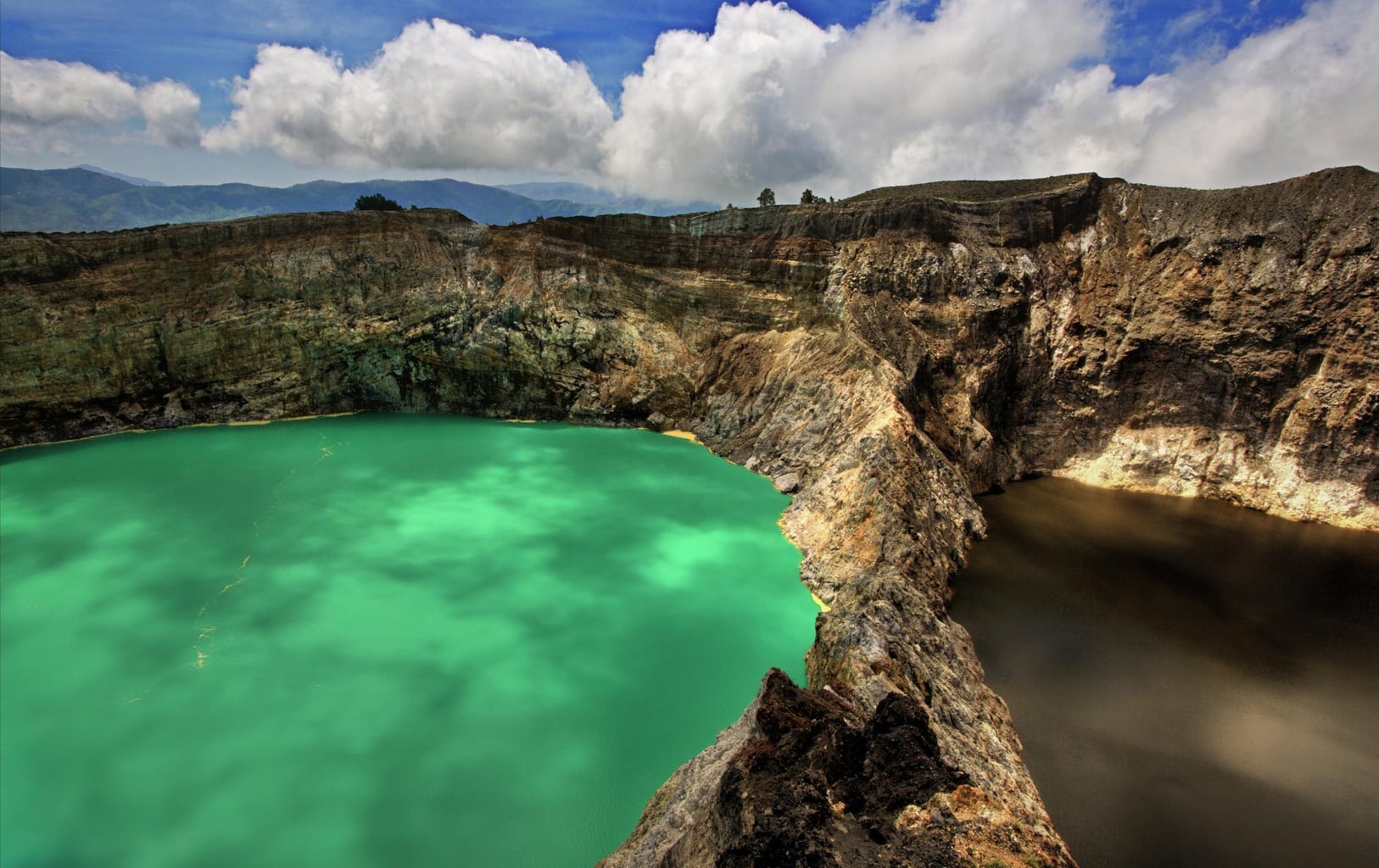
 In short
In short
There are many interesting crater lakes around the world and many are exciting natural wonders. Some of the most surprising are the three Kelimutu crater lakes in Flores island, Indonesia.
 61.8%
61.8%
GPS coordinates
Location, address
Height
Alternate names
Map of the site
If you see this after your page is loaded completely, leafletJS files are missing.
 In detail
In detail
Crater lakes
Bowl-shaped hollows near the summit of volcanoes – craters – often are filled with lakes. Most of their water comes from rain and also small streams. Crater lakes “sit” on the top of volcanic vents and often through these vents in the lake water are injected gases, sulfur, metals, and other substances.
Thus volcanic crater lakes are quite unusual. Frequently these lakes are acidic – volcanic vent injects sulfur, which reacts with water and creates sulfuric acid. Sometimes these lakes consist of almost pure acid.
The color of water in volcanic crater lakes also might be unusual – these lakes can be light blue, green, white, or even red.
Wonder of Kelimutu
Volcano
Kelimutu is a dormant stratovolcano – a steep-sided volcano with a crater on its top. Around the summit of the volcano has developed lush tropical forest with rare and even unique species. Some of the best known are two unique plants: uta onga Begonia kelimutuensis and turuwara (Rhododendron reschinum).
There have been no large eruptions in the historic time – only comparatively small phreatic eruptions, e.g. steam explosions, as the groundwater reaches magma. Last took place in June 1968.
Kelimutu crater lakes
On the eastern summit of Kelimutu are located three crater lakes – each with its own geochemical and hydrothermal regime. Thus, even if they are located close together, each of these lakes lives its own life.
As a result, each of the Kelimutu crater lakes has its own color, and this color changes over time irrespective of the changes in the other two lakes.
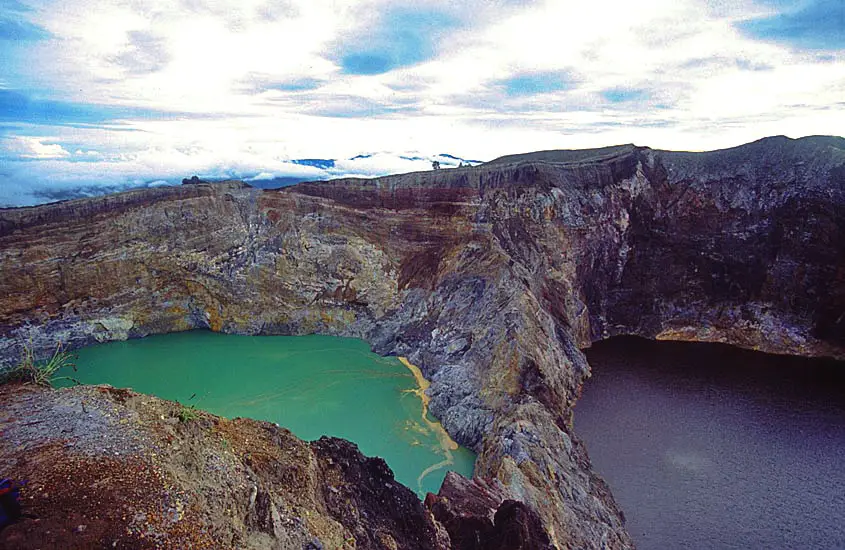
These lakes are:
– Tiwu Ata Bupu (Lake of Old People), also Tiwu Ata Mbupu. This lake is up to 67 m deep and has a diameter of 260 – 360 m. It stands a bit separately, further to the west, and usually is blue. Kemmerling in the 1920ies reported about fumarolic activity around this lake – now it is not observed anymore. Around the shoreline has formed a film of volcanic minerals in bright red, orange, and yellow colors, gypsum crystals are forming in the cracks near the lake. This lake has a small, weak input of volcanic gases;
– Tiwu Ko’o Fai Nuwa Muri (Lake of Young Men and Maidens), also Tiwu Nua Muri Koohi Fah. This lake is approximately 300 – 430 m wide and up to 127 m deep. Kemmerling in 1920ies reported about fumarolic activity above the shoreline of this lake as well but now it is calm here too. An underwater fumarole is located under the center of this lake. This might be sulfuric fumarole because on the surface of the lake is forming a yellow froth, which is pushed towards the shores. This lake could have copper-rich sediments. Currently, this lake has more active fumaroles than the others – an influx of sulfur dioxide per day reaches 85 tons;
– Tiwu Ata Polo (Bewitched or Enchanted Lake). It seems – under the northwestern part of this lake is fumarole – often there is observed a white froth and bubbles on the lake’s surface. Lake is some 330 – 400 m wide and up to 64 m deep. This is an acid-saline volcanic lake where the color changes could be a direct result of changes in the oxidation state of the lake’s water.
Both last lakes are located close together and are divided by a natural dam, which raises some 35 m above the lake level. The dam is not stable – one day it may collapse and both unique lakes would turn into one.
Color changes
All three lakes are fed by similar volcanic gases but the supplied amount and chemical content of this gas fluctuate for each of the lakes separately. Thus, thanks to complex chemical processes of oxidation and reduction the color of lakes is changing over time. For example, in January – November 2016 the color changed six times.
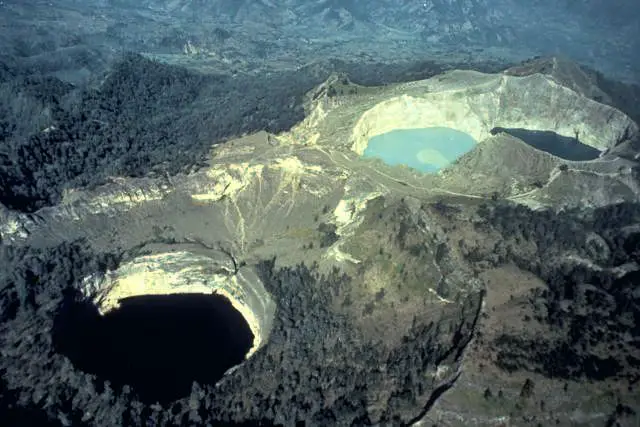
The main determinant of the changes in the color of lakes is the content of oxygen. If there is less oxygen in the lakes, they become more green. If lake is rich with oxygen, its color is deep red to black.
A process of oxidation is influenced by the rain and input of volcanic gases and groundwater. As lakes are not connected, chemical processes in each of them are independent – thus also their color changes independently.
Thus Kelimutu has obtained unique natural decoration – three lakes that always have different colors. There is no other volcano on Earth with similar phenomena.
History
Locals, of course, have known about these lakes since antiquity but the first known European to reach them could be French naturalist Leroux, who mentioned these unusual lakes in his travel log in 1896. A more extended scientific description was made by the Dutch colonial geologist Kemmerling in the 1920ies.
Over time lakes have been much studied and the chemical processes of the unique lakes are more or less clear. At the same time, a proper volcanological monitoring system here still is missing.
In 1992 was founded Kelimutu National Park with an area of 5,300 hectares and over the last decades, there has been reached a certain equilibrium between the interests of nature conservation, local people, and an increasing stream of tourists. Tourists now love to visit the summit of Kelimutu at sunrise and enjoy the unique view of three diversely colored lakes basking in the lush light of the rising Sun.
References
- Dr. Gregory B. Pasternack. Keli Mutu. Accessed on September 16, 2018
- Gregory B. Pasternack and Johan C. Varekamp. The geochemistry of Keli Mutu crater lakes, Flores, Indonesia. Geochemical Journal, Vol.28, pp.243 to 262, 1994
Kelimutu crater lakes are included in the following article:
 Linked articles
Linked articles
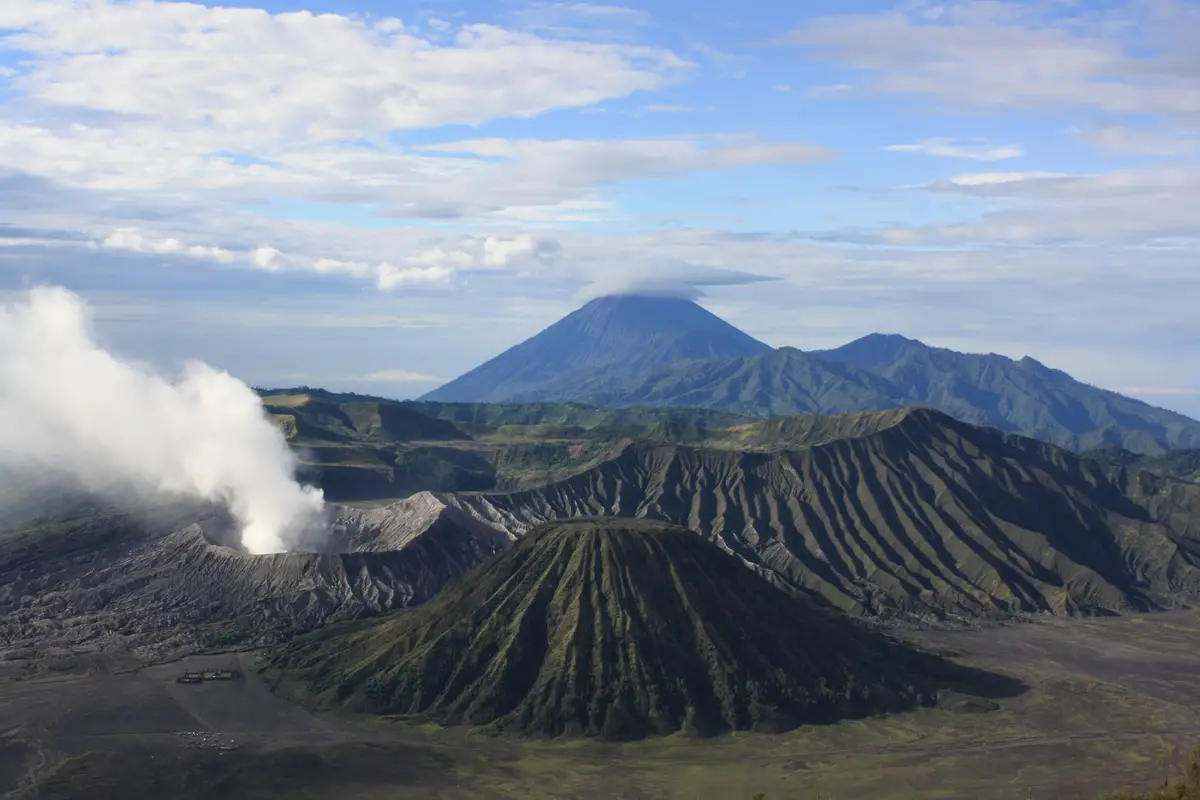
Wonders of Indonesia
Indonesia is a true land of wonders. There are few other countries in the world that can offer a similar array of diverse, unique, and beautiful natural and cultural monuments.
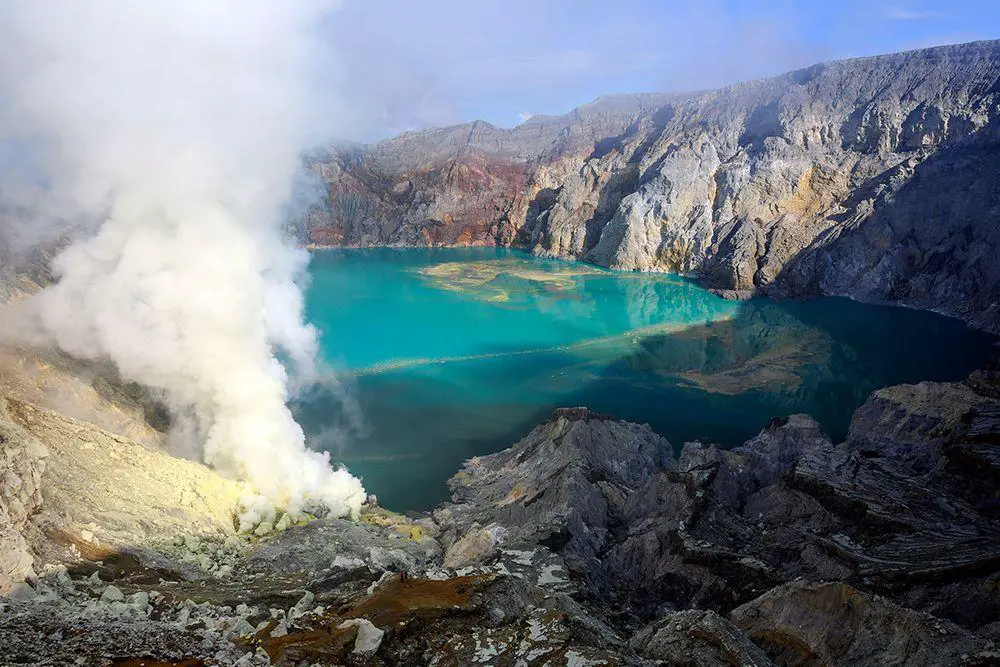
Lakes and streams
There are many factors that can make lakes, sea bays, or rivers unusual. Some lakes have unusual chemical properties and even do not contain water at all – such as lava lakes. Others may have unusual animals living in them or… legends about such animals.
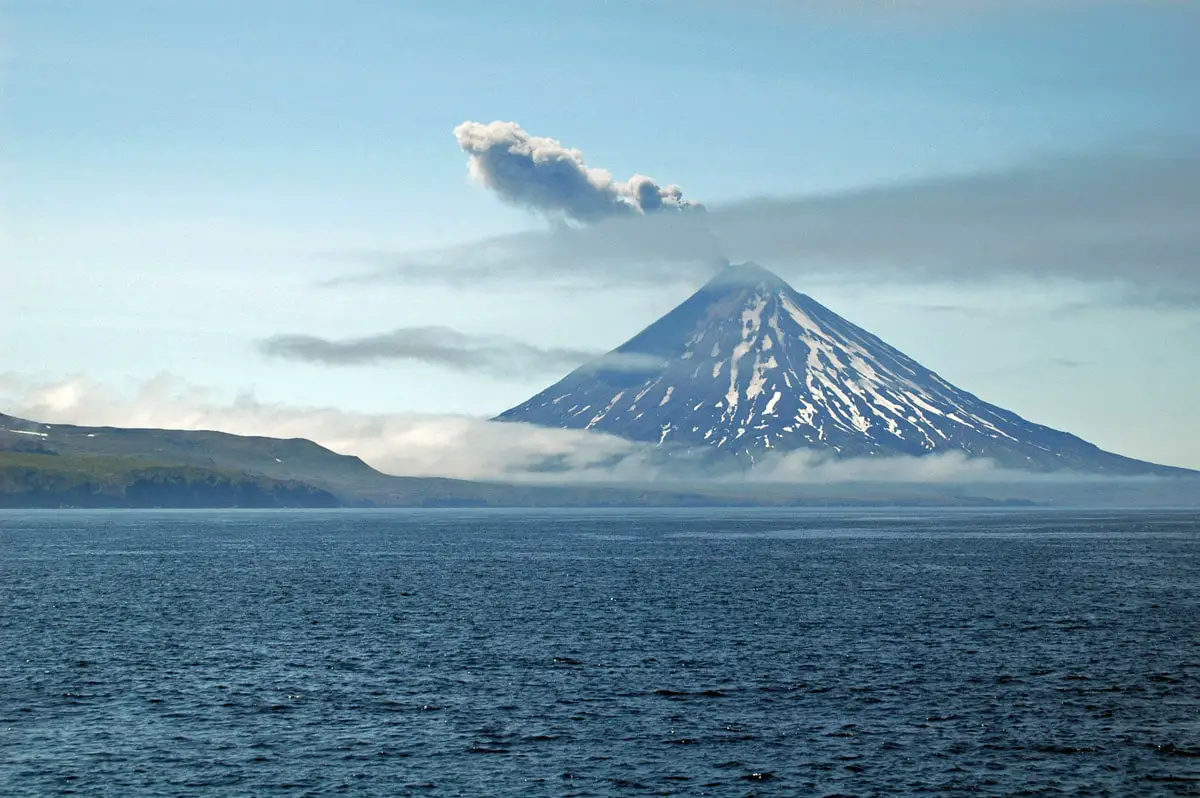
Volcanoes
This category includes the most unusual and interesting volcanoes of the world.
Over the last 10,000 years in some 1,500 places around the Earth mantle of Earth has emitted lava, ash, and gases through the crust of the planet. Each of these places is an active volcano. Some 50 – 70 volcanoes erupt every year and at any moment there are some 20 – 30 eruptions ongoing.
 Recommended books
Recommended books
South East Asian Railway Journeys Jakarta to Banyuwangi
This travelogue describes the sixth of a series of long-distance journeys through South East Asia. It covers the train trip from Jakarta through the northern part of Java to Banyuwangi on the eastern coast of the island. Thereafter, the ferry crossing to Bali is described as well as the bus trip to Denpasar. The content is anecdotal and richly illustrated with photographs.
Journeys with the caterpillar: Travelling through the islands of Flores and Sumba, Indonesia
A humorous travelogue on Indonesia.



